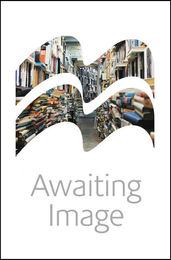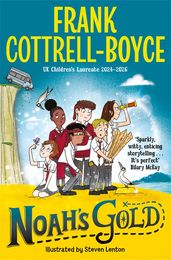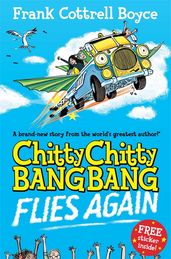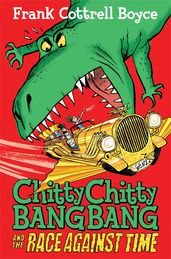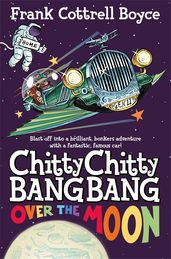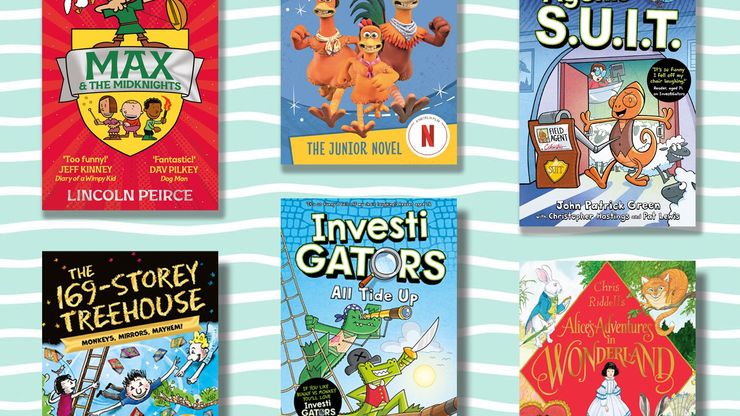Frank Cottrell-Boyce's books: a complete guide
Frank Cottrell-Boyce is the bestselling author of Millions, Cosmic and many other books for children. Here’s our guide to his work.
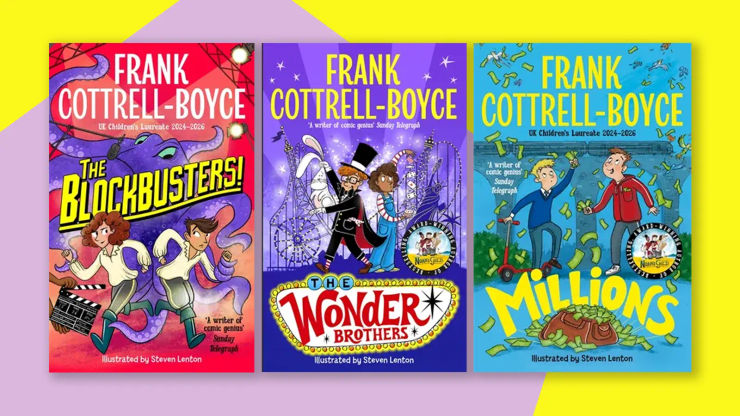
Frank Cottrell-Boyce's children's books are touching, brilliantly clever, and extremely funny. An award-winning author and screenwriter (including for Dr Who) he also co-devised, with Danny Boyle, the opening ceremony of the London 2012 Olympics. He is the UK children's laureate for 2024-26. Young readers and their carers will love his hilarious, entertaining stories with heart.
What is Frank Cottrell-Boyce’s latest book?
The Blockbusters!
by Frank Cottrell-Boyce
Lights, camera, chaos! The Blockbusters! is a laugh-out-loud adventure bursting with heart and Hollywood hijinks. When new boy Rafa and his friends stumble onto the set of a blockbuster movie, Rafa’s uncanny resemblance to a famous star catapults him into the spotlight – complete with VIP treatment and unlimited doughnuts! But amidst the glitz and glamour, Rafa has a mission: to find his missing brother, Cillian, who’s left a mysterious clue. Illustrated by Steven Lenton, this action-packed, warm-hearted tale is perfect for readers who love adventure, comedy, and a touch of movie magic!
Frank Cottrell-Boyce's books for 9 – 12 year olds
The Wonder Brothers
by Frank Cottrell-Boyce
Cousins Middy and Nathan love magic. The on-stage, cape-swirling, bunny-out-of-a-hat kind. For Middy, it’s all about patience and practice. She uses magic skills to help her out of tricky situations. Nathan, however, is a show-off, drawn to the sensation, spectacle and audience. So when the famous Blackpool Tower dramatically vanishes the night of the Grand Lights Switch-On, showman Nathan announces live on TV that they will magic it back home. With a stick of rock, a spangly cape, and a bit of misdirection, the cousins end up lost in Las Vegas, home to the grand master of illusion, Perplexion, ‘Legend of Magic’.
Millions
by Frank Cottrell-Boyce
Also a major film, directed by Danny Boyle, Millions is a heart-achingly funny, touching and brilliantly clever adventure about two boys, one miracle and a million choices. Brothers Damian and Anthony didn't mean to get caught up in a botched train robbery. But what would you do if a massive bag of cash dropped from the sky and you had only a few days to spend it before it became worthless? Buy a million pizzas? End world poverty? Not such an easy decision, is it? The boys soon find out that being rich is a mug's game. And not only is the clock ticking, but the bank robbers want their money back . . .
Framed
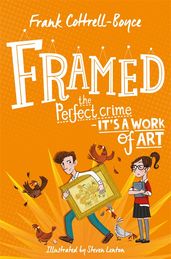
Framed is inspired by a true story: during World War Two, art from London's National Gallery was stored away secretly in Welsh slate mines to keep it safe during the Blitz. The story follows Dylan, the only boy living in the tiny Welsh town of Manod. His parents run the Snowdonia Oasis Auto Marvel garage and Dylan is in charge of the petrol log. And that means he gets to keep track of everyone coming in and out of Manod – what car they drive, what they're called, even their favourite flavour of crisps. But when a mysterious convoy of lorries trundles up the misty mountainside towards an old, disused mine, even Dylan is confounded. Who are these people – and what have they got to hide?
Cosmic
by Frank Cottrell-Boyce
Liam is too big for his boots. And his football strip. And his school blazer. But being super-sized height-wise has its advantages: he's the only eleven-year-old to ever ride the G-force-defying Cosmic rollercoaster, or to be offered the chance to drive a Porsche. Long-legged Liam makes a giant leap for boy-kind by competing with a group of adults for the chance to go into space. Is Liam the best boy for the job? Sometimes being big isn't all about being a grown-up.
The Astounding Broccoli Boy
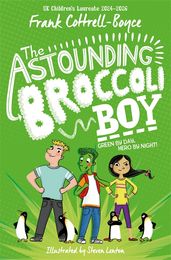
Just because something is unlikely doesn't mean it won't ever happen . . . Rory Rooney likes to be ready for anything. His favourite book is Don't Be Scared, Be Prepared. He knows how to survive a hippo attack. He is not, however, sure what to do when he suddenly and inexplicably turns green. Stuck in an isolation ward in a hospital far from home with two other remarkably green children, Rory's as confused by his new condition as the medics seem to be. Could he have turned into a superhero? If only he could make it past hospital security and find out what his superpower might be.
Sputnik's Guide to Life on Earth

The Blythes are a big, warm, rambunctious family who live on a small farm and sometimes foster children. Like Prez, who has just arrived. He's cheerful and helpful, but never says a word. Then one day Prez answers the door to someone claiming to be his relative; a small, loud stranger with a backpack and a swagger who goes by the name of Sputnik. Suddenly household items come to life and Prez is going to have to use his voice to explain himself. As Sputnik takes Prez on a journey to finish writing his guidebook Ten Things Worth Doing on Earth, each adventure seems to take Prez nearer to the heart of the family he is being fostered by, but also closer to the day that he is due to leave them forever.
Runaway Robot
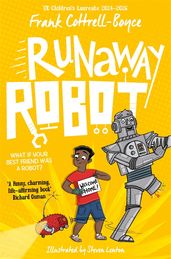
When Alfie goes to Airport Lost Property, he finds more than he bargained for. A lot more. Because there's a giant robot called Eric hidden away on the shelves. Eric has lost one leg and half his memory. He's very strong, and very clumsy. He's also convinced that he's the latest technology, when he's actually nearly one hundred years old and ready for the scrap heap. Can Alfie find a way to save Eric from destruction – before Eric destroys everything around him?
The Great Rocket Robbery
by Frank Cottrell-Boyce
One of World Book Day 2019's free books, and now available as an ebook for 99p, The Great Rocket Robbery is the story of Laika and her fellow street dogs as they're trained up for a trip to the moon! But Laika can't wait to see the stars – so she hatches a plan with her friends to get her there all on her own.
Noah's Gold
by Frank Cottrell-Boyce
Eleven-year old Noah sneaks along on his big sister's geography field trip, and this turns out to be quite a bad idea. Six kids are marooned on an uninhabited island. Their teacher has vanished. They're hungry. Their phones don't work and Noah has broken the internet. There's no way of contacting home . . . Disaster! Until Noah discovers a treasure map and the gang goes in search of gold.
Frank Cottrell-Boyce's books for 6 – 8 year olds
Chitty Chitty Bang Bang Flies Again
by Frank Cottrell-Boyce
Packed with fun illustrations by Joe Berger, Chitty Chitty Bang Bang Flies Again is the hilarious sequel to Ian Fleming's much loved children's classic. When the Tooting family find a vast abandoned engine and fit it to their camper van, they have no idea of the adventure that lies ahead. The engine used to belong to an extraordinary flying car – and it wants to be back on the road again! The Tootings can haul on the steering wheel and pull the handbrake as hard as they like, but their camper van now has a mind of her own. It's not long before they're hurtling along on a turbocharged chase as Chitty tracks down her long-lost bodywork. But there are sinister forces at work too.
Chitty Chitty Bang Bang and the Race Against Time
by Joe Berger
More fun, fast, feel-good adventure with the world's greatest car, driven by the world's most hapless family. Uh-oh! Chitty Chitty Bang Bang is stuck in reverse. And Little Harry's pressed a button that means Chitty is reversing through time – with the Tootings aboard. When they finally come to a stop, it's at the feet of a very hungry-looking T-rex. How are the Tootings – and Chitty – going to get out of this one?
Chitty Chitty Bang Bang Over the Moon
by Joe Berger
The Tootings are stuck in 1966! Somebody's stolen Chitty Chitty Bang Bang and left them behind. And they've also taken Little Harry. There's only one solution. The Tootings must find the Potts – the family that originally built Chitty. Sharing their combined knowledge of how Chitty works, the families stand a chance of rescuing Little Harry and finding the most brilliant car in the world. But a fiendish criminal has different plans, ones that involve flying Chitty Chitty Bang Bang to the moon and putting an explosive scheme into action.
